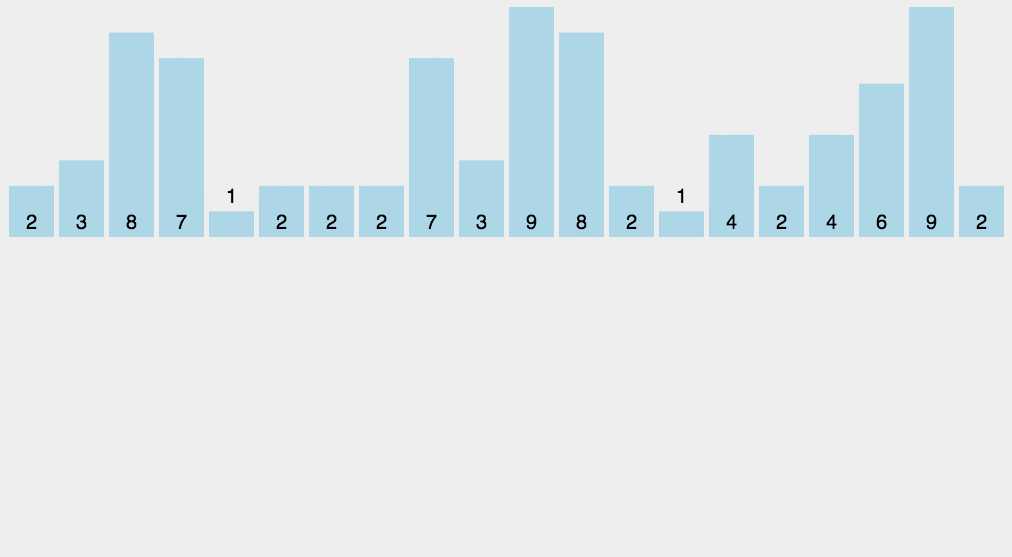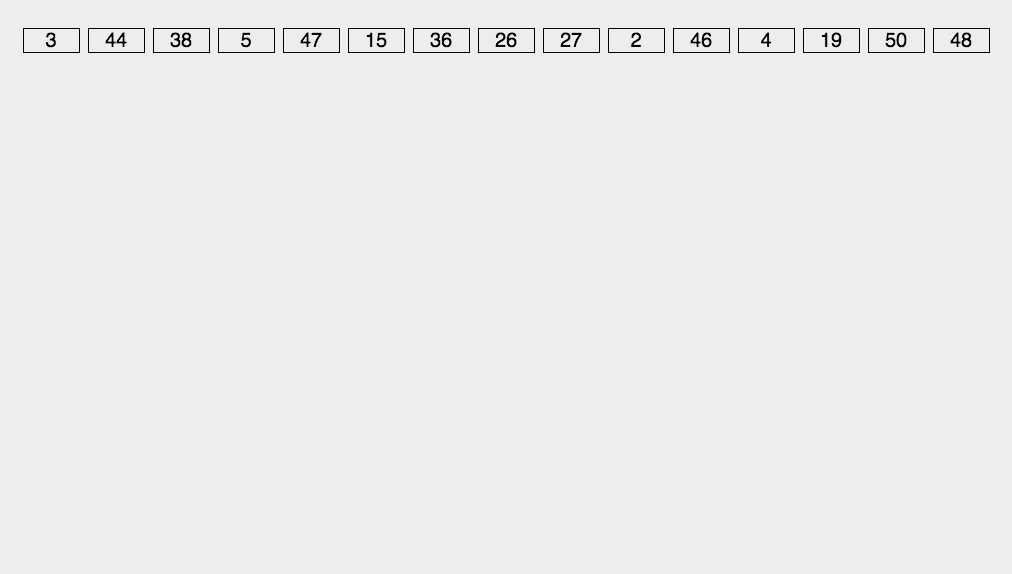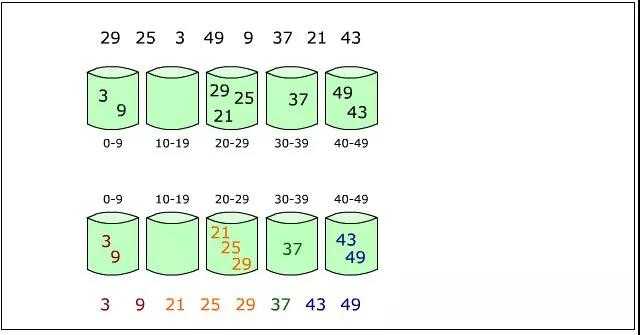常見排序算法(三)
計數排序:
1、一個非基於比較的排序算法,該算法於1954年由 Harold H. Seward 提出,它的優勢在於在對一定範圍內的整數排序,
其時間復雜度為Ο(n+k)(其中k是整數的範圍),快於任何比較排序算法
2、步驟:
a、找出給定整數序列的最大值 max 和最小值 min,創建大小為 max-min+1 的輔助空間,其值為 0
b、最小的那個數下標為 0,最大數下標為 -1,其他數 num 的下標為 num-min
c、根據遍歷所找到的數,在其相應下標處的值加一
d、遍歷輔助空間,輸出對應下標的數,其輸出次數為下標處的值
註:該算法是以空間換時間,若待排序列不是整數,則最好不要使用,因為浮點數範圍比較大,即使像在 [0, 1) 這個區間也可以有極多個


#include <iostream> #include <vector> #include <algorithm> void countSort(std::vector<int>& nums); int main() { std::vector<int> nums; intView Codelen = 0; std::cout<<"請輸入長度:"; do { std::cin>>len; if (len <= 0) std::cerr<<"請輸入正整數:"; } while (len <= 0); int num = 0; std::cout<<"輸入 "<<len<<" 個數: "; for (size_t i = 0; i < len; ++i) { std::cin>>num; nums.push_back(num); } std::cout<<"排序後的數組:"; countSort(nums); system("pause"); return 0; } void countSort(std::vector<int>& nums) { // 註意要使用 ‘*‘ 號,因為它們找到的都是位置,這兩個函數都包含在 algorithm 裏面 int max = *max_element(nums.begin(), nums.end()); int min = *min_element(nums.begin(), nums.end()); int size = max - min + 1; // 創建輔助空間,初始化為 0 std::vector<int> temp(size, 0); // 將對應下標的數出現次數加一 for (auto num : nums) temp[num-min] += 1; for (int i = 0; i < size; ++i) { int count = temp[i]; // 根據次數輸出,我們在這裏沒有改變原序列的順序, // 僅僅輸出排序後的序列,若要改變原序列,需要執行復制操作 while (count > 0) { std::cout<<i+min<<std::ends; count--; } } std::cout<<std::endl; }
基數排序:
1、基數排序是根據待排序列的元素的位來進行排序的,是一種非比較排序;它可以分為兩類:
最低位優先法,簡稱 LSD 法:先從最低位開始排序,再對次低位排序,直到對最高位排序後得到一個有序序列
最高位優先法,簡稱 MSD 法:先從最高位開始排序,再逐個對各分組按次高位進行子排序,循環直到最低位
以下是 LSD 的動態演示圖
2、步驟(LSD):
a、根據待排序的元素的最多位數確定循環次數,如最多位的數位 12345,則循環 5 次
b、創建 10 張空表,分別表示 0~9
c、從最低位開始,根據位上的數值選擇放入的表,如 123 在最低位上的數為 3,則放到下標為 3 的表裏
d、按順序將表裏的元素取出,替換原序列的數
e、向高移動一位,重復操作 c 和 d,直至循環次數


#include <iostream> #include <vector> #include <cmath> #include <algorithm> #include <cstdlib> int get_times(int num); int get_digit(int num, int d); void radixSort(std::vector<int>& nums); int main() { std::vector<int> nums; int len = 0; std::cout<<"請輸入長度:"; do { std::cin>>len; if (len <= 0) std::cerr<<"請輸入正整數:"; } while (len <= 0); int num = 0; std::cout<<"輸入 "<<len<<" 個數: "; for (size_t i = 0; i < len; ++i) { std::cin>>num; nums.push_back(num); } radixSort(nums); std::cout<<"排序後的數組:"; for (int num : nums) std::cout<<num<<std::ends; std::cout<<std::endl; system("pause"); return 0; } // 獲取第 d 位的數值 int get_digit(int num, int d) { return int(num / pow(10, d)) % 10; } // 獲取需要循環的次數 int get_times(int num) { int times = 0; while (num) { times++; num /= 10; } return times; } //沒有考慮負數的情況,如果需要的話可以使用兩個數組,一個存放正數,一個存放負數 void radixSort(std::vector<int>& nums) { int max = *max_element(nums.begin(), nums.end()); int times = get_times(max); int len = nums.size(); for (size_t i = 0; i < times; ++i) { std::vector<std::vector<int>> temp(10); for (int num : nums) { temp[get_digit(num, i)].push_back(num); } // 清除數組內容 nums.clear(); // 賦值 for (auto vec : temp) { for (int num : vec) { nums.push_back(num); } } } return ; }View Code
桶排序:
1、掃描選出待排序列的最大 max 和最小值 min,設有 k 個桶,則我們把區間 [min, max] 均勻地劃分為 k 個區間,
每個區間就是一個桶,然後再將待排序列地元素分配到各自的桶裏,即數值的大小在哪個區間就分配到哪
2、對每個桶裏的元素進行排序,可以選擇任意一種算法
3、將各個桶裏的元素合並成一個大的有序序列


#include <iostream> #include <vector> #include <cstdlib> #include <algorithm> void bucketSort(std::vector<int>& num); int main() { std::vector<int> nums; int len = 0; std::cout<<"請輸入長度:"; do { std::cin>>len; if (len <= 0) std::cerr<<"請輸入正整數:"; } while (len <= 0); int num = 0; std::cout<<"輸入 "<<len<<" 個數: "; for (size_t i = 0; i < len; ++i) { std::cin>>num; nums.push_back(num); } std::cout<<"排序後的數組:"; bucketSort(nums); system("pause"); return 0; } //這個排序我沒有改變原序列的順序,僅僅只是輸出有序序列,若要改變原序列,請添加賦值操作 void bucketSort(std::vector<int>& nums) { // 尋找最大最小值 int max = *max_element(nums.begin(), nums.end()); int min = *min_element(nums.begin(), nums.end()); // 為方便起見,桶個數直接采用範圍大小 int buckets_num = max-min+1; std::vector<std::vector<int>> res(buckets_num); for (int num : nums) { // 按數壓入 res[num-min].push_back(num); } for (auto vec : res) { // 桶內排序 sort(vec.begin(), vec.end()); } for (auto vec : res) for (int num : vec) std::cout<<num<<std::ends; std::cout<<std::endl; return ; }View Code
常見排序算法(三)

